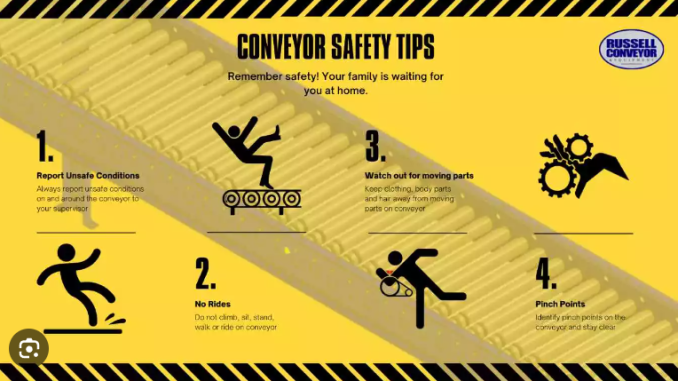
Ensuring the safety of conveyor belt systems is a critical concern in the industrial and manufacturing sectors. Adhering to best practices at all times is not just about compliance; it’s about safeguarding lives and maintaining operational efficiency. This article delves into the fundamental practices that uphold the safety and integrity of these systems.
In the world of conveyor belts, constant vigilance and adherence to established safety protocols are non-negotiable. From routine maintenance to comprehensive operator training, this article aims to highlight the key strategies for maintaining a safe conveyor belt system, thus minimizing risks and preventing potential accidents.
Understanding Conveyor Belt Risks
Conveyor belt risk assessment is a critical step in understanding and mitigating hazards associated with their operation. Common risks include entanglement, slips, and electrical issues, which can lead to severe accidents if not properly managed. Recognizing these dangers is the first step in creating a safer work environment.
Best practices to follow
In the realm of industrial and manufacturing operations, the safety of conveyor belt systems is paramount. Let us shed light on the best practices for ensuring safety during the operation of conveyor belts. We will delve into maintenance, training, emergency procedures, and the importance of choosing the right equipment, all with a focus on minimizing risks and preventing accidents.
- Regular Maintenance and Inspections
Conveyor belt maintenance is crucial in preventing malfunctions that could lead to accidents. A comprehensive conveyor belt inspection checklist should include examining the belt’s integrity, motor, and emergency stop mechanisms. Regular inspections and maintenance not only ensure operational safety but also extend the life of the conveyor system.
- Comprehensive Training for Operators
Training for conveyor belt operators is essential. It should cover operation protocols, emergency stop procedures, and hazard recognition. Well-trained personnel are less likely to make errors that could lead to accidents, ensuring smoother and safer conveyor operations.
- Implementing Effective Emergency Procedures
Developing and implementing emergency procedures for conveyor incidents is vital. These procedures should be clear and well-communicated, ensuring quick and effective responses to emergencies, minimizing risks to personnel and equipment.
- Choosing the Right Conveyor Belt Equipment
Safety in conveyor operation begins with choosing the right conveyor belt for safety. Factors such as the material being transported, the environment of operation, and safety features like conveyor belt guarding should be considered to enhance overall safety.
- Creating a Safety-First Culture
A safety-first culture is instrumental in minimizing conveyor belt accidents. This involves not only adhering to conveyor belt safety standards but also encouraging every team member to prioritize safety in their daily tasks and responsibilities.
Legal Compliance and Safety Standards
Adhering to legal requirements and conveyor belt safety standards is essential, carrying both legal and moral weight. These standards are not arbitrary; they are meticulously designed to safeguard operators and ensure the smooth, safe functioning of conveyor belt systems. Here’s a detailed breakdown:
- Understanding Legal Requirements
Each region or country has specific legal standards governing the operation of conveyor belts in industrial settings. Compliance involves regular audits and adherence to these laws, ensuring that conveyor belt systems meet all regional safety regulations.
- Adopting Conveyor Belt Safety Standards
Conveyor belt safety standards are detailed guidelines set by industry bodies and safety organizations. These standards cover everything from the design and installation of conveyor belts to their maintenance and operation. Regular training and updates for staff on these standards are crucial for continuous compliance.
- Routine Safety Audits and Inspections
Conducting regular safety audits and inspections is a key aspect of compliance. These audits help in identifying potential hazards and ensuring that all aspects of the conveyor system are up to code.
- Documenting Compliance and Incidents
Keeping detailed records of compliance efforts, including maintenance logs and training records, is vital. Documentation is not only a legal requirement but also an essential tool in incident analysis and future safety planning.
- Continuous Education and Training
Ongoing education and training on safety standards and legal requirements for all staff involved in conveyor belt operation. This ensures that the workforce is always up-to-date with the latest safety protocols and legal changes.
- Incorporating Safety Standards in Daily Operations
Safety standards should be integrated into the daily operational procedures of conveyor belt systems. This includes regular maintenance checks, adherence to operational protocols, and ensuring conveyor belt safety signage is clear and visible.
By elaborating on these aspects, the importance of legal compliance and adherence to safety standards in the operation of conveyor belts is underscored. It’s not just about fulfilling legal obligations but about embedding a culture of safety in the very fabric of conveyor belt operations.
Trust the Best Conveyor Belt
This article has highlighted the critical nature of safety in the operation of conveyor belts. By adhering to these guidelines and standards, operators can ensure a safer working environment, reducing the likelihood of accidents and promoting efficiency.
Prioritize safety in your operations! Explore our guide for best practices in conveyor belt safety to minimize risks and enhance workplace security with https://th.misumi-ec.com/. Ensure the well-being of your team with proper conveyor belt operation.

Leave a Reply